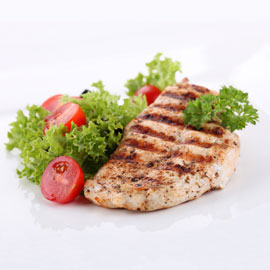 Protein is one of the most essential nutrients in any healthy diet. However, many high-protein foods are also high in fat, and this can cause acid reflux and heartburn in those who suffer from gastroesophageal reflux disease (GERD).
Protein is one of the most essential nutrients in any healthy diet. However, many high-protein foods are also high in fat, and this can cause acid reflux and heartburn in those who suffer from gastroesophageal reflux disease (GERD).
Learning to choose and prepare proteins in a way that minimizes your risk of acid reflux can be a valuable part of staying healthy while living with GERD.
Why is Protein Important?
Protein is one of the primary building blocks of our bodies. It helps us create and repair tissue throughout the entire body. It’s essential to growth, development and healing.
Protein can also help with weight loss, which makes it especially important to those struggling with GERD due to obesity. Eating enough protein while you lose weight can help you ensure that your body gets rid of fat instead of lean muscle mass.
We need to include enough protein in our diets to maintain these important functions. In general, the recommended daily intake of protein is:
- Adult men: 56 grams
- Adult women: 46 grams
Most people who follow a balanced diet are able to eat this amount of protein each day without requiring supplements. However, for those who suffer from GERD, some sources of protein may cause discomfort, and it is important to carefully choose proteins that minimize the risk of symptoms.
How Can I Eat Protein Without Causing Heartburn?
Because fatty foods are among the most common triggers of acid reflux and heartburn, most GERD sufferers should strive to eat proteins that contain a minimal amount of fat. This can be accomplished by:
Choosing Lean Proteins
Though foods like beef, pork and cheese and high in protein, they are also often high in fat. To minimize your fat intake and maximize your protein intake, it is best to choose lower-fat proteins like:
- Fish
- Shellfish
- Skinless chicken or turkey breast
- Legumes like black beans, lentils and garbanzo beans
- Soy products like tofu and tempeh
- Low-fat dairy products
It is possible to find leaner cuts of beef and pork, like top sirloin, tenderloin and round. Though you may be able to eat these cuts of meat without experiencing GERD symptoms, it is best to slowly and carefully introduce them to your diet to see how your body reacts.
Using Low-Fat Cooking Methods
Cooking methods like frying can quickly turn even the leanest protein source into heartburn triggers because they add fat during preparation. It’s best to use cooking methods that require little or no fat to be added, like:
- Grilling. Using a grill requires no added fat and allows fat to drip away from meat as it cooks.
- Microwaving. Using a microwave is an excellent way to keep meats moist without adding fat.
- Baking. An oven uses dry heat and no fat is necessary during cooking. However, to keep meats moist, it is often best to wrap them in foil while baking them.
- Poaching. Immersing meats like chicken and fish in boiling water can cook them quickly without adding any fat to your meal.
After using one of these cooking methods, remember to also avoid adding fatty toppings like cheese, mayonnaise or dressing to cut down on the fat content of your food.
By selecting the leanest protein sources and using healthy cooking methods, you can ensure that you get enough protein to stay healthy without increasing your risk of acid reflux.

Leave a Reply